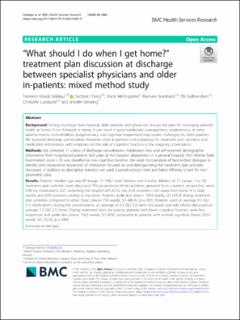| dc.contributor.author | Siddiqui, Tahreem Ghazal | |
| dc.contributor.author | Cheng, Socheat | |
| dc.contributor.author | Mellingsæter, Marte | |
| dc.contributor.author | Grambaite, Ramune | |
| dc.contributor.author | Gulbrandsen, Pål | |
| dc.contributor.author | Lundqvist, Christofer | |
| dc.contributor.author | Gerwing, Jennifer | |
| dc.date.accessioned | 2021-01-26T09:31:47Z | |
| dc.date.available | 2021-01-26T09:31:47Z | |
| dc.date.created | 2020-11-10T10:29:04Z | |
| dc.date.issued | 2020 | |
| dc.identifier.citation | BMC Health Services Research. 2020, 20, . | en_US |
| dc.identifier.issn | 1472-6963 | |
| dc.identifier.uri | https://hdl.handle.net/11250/2724715 | |
| dc.description.abstract | Background
During discharge from hospital, older patients and physicians discuss the plan for managing patients’ health at home. If not followed at home, it can result in poor medication management, readmissions, or other adverse events. Comorbidities, polypharmacy and cognitive impairment may create challenges for older patients. We assessed discharge conversations between older in-patients and physicians for treatment plan activities and medication information, with emphasis on the role of cognitive function in the ongoing conversation.
Methods
We collected 11 videos of discharge consultations, medication lists, and self-reported demographic information from hospitalised patients ≥65 years at the Geriatric department in a general hospital. Mini Mental State Examination score < 25 was classified as low cognitive function. We used microanalysis of face-to-face dialogue to identify and characterise sequences of interaction focused on and distinguishing the treatment plan activities discussed. In addition to descriptive statistics, we used a paired-sample t-test and Mann-Whitney U test for non-parametric data.
Results
Patients’ median age was 85 (range: 71–90);7 were females and 4 males. Median of 17 (range: 7 to 23) treatment plan activities were discussed. The proportions of the activities, grouped from a patient perspective, were: 0.40 my medications, 0.21 something the hospital will do for me, 0.18 someone I visit away from home, 0.12 daily routine and 0.09 someone coming to my home. Patients spoke less (mean 190.9 words, SD 133.9) during treatment plan activities compared to other topics (mean 759 words, SD 480.4), (p = .001). Patients used on average 9.2 (SD 3.1) medications; during the conversations, an average of 4.5 (SD 3.3) were discussed, and side effects discussed on average 1.2 (SD 2.1) times. During treatment plan discussions, patients with lower cognitive function were less responsive and spoke less (mean 116.5 words, SD 40.9), compared to patients with normal cognition (mean 233.4 words, SD 152.4), (p = .089).
Conclusion
Physicians and geriatric patients discuss many activities during discharge conversations, mostly focusing on medication use without stating side effects. Cognitive function might play a role in how older patients respond. These results may be useful for an intervention to improve communication between physicians and older hospitalised patients. | en_US |
| dc.language.iso | eng | en_US |
| dc.publisher | BioMed Central | en_US |
| dc.rights | Navngivelse 4.0 Internasjonal | * |
| dc.rights.uri | http://creativecommons.org/licenses/by/4.0/deed.no | * |
| dc.title | “What should I do when I get home?” treatment plan discussion at discharge between specialist physicians and older in-patients: mixed method study | en_US |
| dc.type | Peer reviewed | en_US |
| dc.type | Journal article | en_US |
| dc.description.version | publishedVersion | en_US |
| dc.source.volume | 20 | en_US |
| dc.source.journal | BMC Health Services Research | en_US |
| dc.identifier.doi | 10.1186/s12913-020-05860-9 | |
| dc.identifier.cristin | 1846452 | |
| dc.description.localcode | This article is licensed under a Creative Commons Attribution 4.0 International License, which permits use, sharing, adaptation, distribution and reproduction in any medium or format, as long as you give appropriate credit to the original author(s) and the source, provide a link to the Creative Commons licence, and indicate if changes were made. The images or other third party material in this article are included in the article's Creative Commons licence, unless indicated otherwise in a credit line to the material. If material is not included in the article's Creative Commons licence and your intended use is not permitted by statutory regulation or exceeds the permitted use, you will need to obtain permission directly from the copyright holder. To view a copy of this licence, visit http://creativecommons.org/licenses/by/4.0/. The Creative Commons Public Domain Dedication waiver (http://creativecommons.org/publicdomain/zero/1.0/) applies to the data made available in this article, unless otherwise stated in a credit line to the data. | en_US |
| dc.source.articlenumber | 1002 | en_US |
| cristin.ispublished | true | |
| cristin.fulltext | original | |
| cristin.qualitycode | 2 | |

